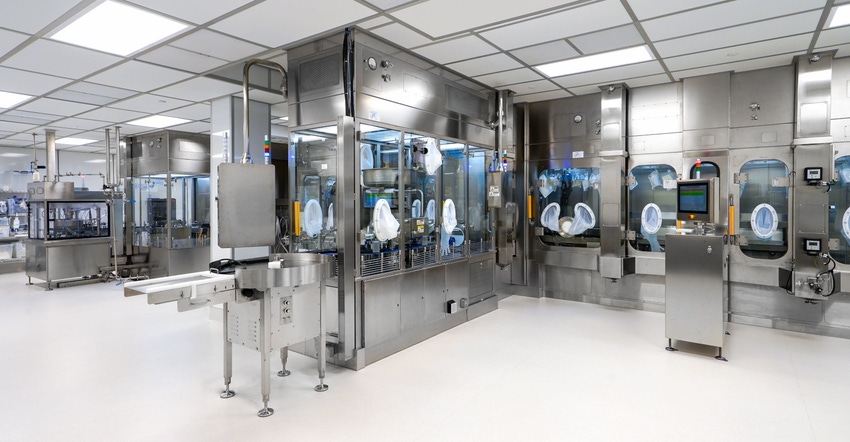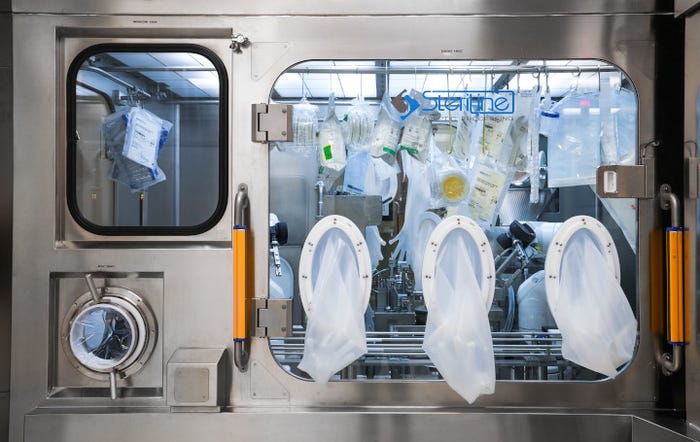Isolator-Based Fill/Finish Line Assures Sterility of Injectible Drugs
Berkshire Sterile Manufacturing enlisted the help of five suppliers to install a fully automated fill/finish line for aseptic pharmaceutical packaging in bulk and ready-to-use glassware.

Consistent growth coupled with a mission to provide the safest sterile drug products possible led contract manufacturer Berkshire Sterile Manufacturing (BSM) to invest in a fully automated, 100% isolator-based sterile fill/finish line with a freeze dryer.
The fill/finish line, supplied primarily by Steriline, processes syringes, cartridges, and vials in bulk and ready-to-use (RTU) tubs for pharmaceutical and biotech companies focused on small-scale and clinical manufacturing.
Prior to installing the new line, BSM’s facility had a filling production range from 2 to 100 milliliters (mL) in glass vials (bulk or RTU), 0.5 to 10mL in glass or polymer syringes, and up to 3mL in glass or polymer cartridges. Product in glass vials can be closed in liquid form or lyophilized (freeze dried).
In 2021, the contract manufacturer invested $20 million to expand its production capacity and capabilities. The investment included additional laboratory and warehouse space and doubled the company’s cleanroom facilities to prepare for the new filling line and freeze dryer.
Providers join forces to deliver flexible fill/finish line solution.
BSM needed a filling line with the capacity for 60,000-unit batches of vials (bulk and RTU), syringes, or cartridges with lyophilization capability up to 35,000-unit batches for 10R vials, including a RTU tub active decontamination system.
The company evaluated local partners and commissioned a filling machine from Colanar, a capping machine from Genesis Packaging Technologies, and a freeze dryer from IMA. To complete the line, Steriline provided the complementary machines and isolators and a robotic tub decontamination system (RTDS2) to decontaminate RTU tubs using a pulsed ultraviolet (UV) light sterilization solution from Claranor.
As primary supplier of the project, Steriline was responsible for providing the following machines and incorporating all of the equipment in a unique, turnkey design: rotary washing machine (RA-V4); vial pusher loading system (VP300); depyrogenation tunnel (ST0-CCS);
rotating table (RT600) linked to a linear belt transfer (LBT); semi-automatic debagging machine (SDB) under open restricted access barrier system (ORABS) for the capper; robotic tub decontamination system (RTDS2); automatic robotic delid/deliner machine (ADE) under isolator; filling machine isolator (ISO); positive diverting system (PDS); laminar air flow system (LAF) for the lyophilizer loader/unloader; and ORABS for the capper.
Working together for the first time, the five providers joined forces to deliver the solution by 2022. As the line needed to handle glass containers in both bulk and RTU tubs, flexibility was essential to handle the different steps for the primary packaging process of each product presentation.

Processing glassware in RTU tubs.
Glassware consisting of vials, syringes, or cartridges in an RTU format arrive nested in thermoformed plastic tubs and are sealed with a liner and Tyvek barrier lid. The tubs are double-bagged, placed in cartons, and palleted. A technician manually unpacks and removes the secondary bag then loads the bagged tub onto a belt that slides to the semi-automatic debagging (SDB) station where the primary bag is removed. The SDB system is situated in a restricted access barrier system (RABS).
This three-chamber decontamination system is the first machine ever to adopt pulsed light technology (PLT) for RTU tubs, according to Steriline.
Tubs are then positioned at the entrance station of the RTDS2. This three-chamber decontamination system is the first machine ever to adopt pulsed light technology (PLT) for RTU tubs, according to Steriline. The tub enters through the inlet chamber, where a robotic arm grips the tub to expose each side of the tub to four xenon lamps (by Claranor) to deliver a series of intense 0.3-microsecond white light flashes at 1 megawatt, providing sufficient power to completely decontaminate the surfaces of the tub.
The system is fitted with a generator that stores energy in a capacitor, and when triggered a pulse of 20 kilovolts and 300 joules ignites the xenon lamps that emit pulsed broad-spectrum UV light flashes that are 50,000 times more intensive than the light from the Sun shining on Earth in a similar surface area. This destroys any microorganisms on the surfaces of the RTU tub prior to entering the filling line. PLT offers highly efficient, effective, and safe sanitization without harming the packaging.
Since PLT is not effective in shadow, the RTDS2 robotic arm rotates the tub to expose all the tub surfaces to the pulsed light lamps, ensuring that all surfaces are properly exposed and decontaminated.
Passing through the outlet chamber, the tub is expelled into the ADE under unidirectional airflow, where a robotic arm removes the Tyvek barrier lid and transfers the tub into the filling machine. After the containers are filled and stoppered, vials can be moved into the freeze dryer (for products requiring lyophilization) or directly into the capping machine to complete the primary packaging process, whereas syringes and cartridges exit the filling machine in their tub.
Processing vials in bulk.
Bulk vials follow a different path: The vials are manually removed from their over-wrapping and loaded onto the rotating table of the RA-V4 rotary washing machine where pincers automatically pick up each vial and reposition it for optimal spray-cleaning and drying during its passage through washing and drying stations.
These washing and drying stations are equipped with needles that are lifted inside the vials to spray water for injection (WFI) and compressed air. After washing and drying, vials are automatically discharged onto the conveyor belt between the washer and depyrogenation tunnel. The rotary washing machine’s integrated control system, which includes a programmable logic controller (PLC) and a human machine interface (HMI), automatically controls all the functional parameters of the machine, according to various vial sizes and types. Parameter data is stored in different recipes, which supervisors and authorized personnel can access via password.
The RA-V4 washer has a footprint of 1,500 x 1,476 millimeters and is designed to process up to 7,200 vials per hour. Parts coming in contact with the interior of the vials and process fluids are made of AISI 316L stainless steel, while other parts are made of AISI 304 stainless steel. RA-V4 is compliant with current Good Manufacturing Practices (cGMP), Good Automated Manufacturing Practice (GAMP), and title 21 of the Code of Federal Regulations Part 11 (21 CFR Part 11) requirements.
Once the vials are washed, the VP300 vial pusher (under LAF) moves the vials into the ST0-CCS depyrogenation tunnel, which measures 1,670mm long x 1,260mm wide x 2,400mm high. The ST0-CCS is composed of three chambers: the inlet chamber, the hot chamber, and the cooling chamber.
The inlet chamber with its laminar flow unit dries and preheats glassware, protecting the vials from the hot air backflow coming from the hot chamber. The hot chamber subjects the glassware to the thermal cycle for depyrogenation. The treatment undertakes glassware at a temperature range of 250° to 340°C to achieve the required 6 log reduction result. (Log reduction is a mathematical term used to express the relative number of living microbes that are eliminated by decontamination.) The duration of this process changes according to the production speed needs. The machine follows validated recipes that have been set to unique time and temperature parameters according to the vial size.
The cooling chamber removes heat from the glassware in a controlled cool-down to reduce thermal shock to the vials. An insulated airtight door at the tunnel exit, equipped with high-temperature-resistant inflatable gaskets, protects the filling isolator during the cooling chamber sterilization. The cooling chamber is sterilized by high-efficiency particulate air (HEPA) filters at a temperature of 160°C. The ST0-CCS conveyor belt width is 300mm, and depyrogenation is performed by 242 cubic meters per hour (m3/h) inlet air. Once glassware cooling achieves the suitable temperature, the vials are discharged onto a linear belt transfer to reach the RT600 rotating table.
The vials are loaded onto a conveyor belt that enters the filling isolator. A robotic arm grabs a line of vials at a time and inserts them in an empty nest. Once the nest is filled, the robot places the nest on the filling station of the Colanar filling and stoppering machine where they are filled and stoppered as required. A second robot removes the filled and stoppered vials and places them on a conveyor that exits the filling isolator through a shutter gate. The vials are either expelled into the IMA freeze dryer if the product requires lyophilization or directly toward the Genesis capping machine for the capping process.

Isolators maintain fill/finish line’s sterility.
In addition to the machines, Steriline delivered the ISOs required for the Colanar filling machine and the ORABS for the capping machine. Steriline ISOs are designed to produce sterile products, some of which are non-toxic to operators and some of which are toxic, such as oncology drugs that can affect and damage human cells.
The ISOs maintain uncompromised, continuous separation of the line’s interior space from the external environment. HEPA-filtered unidirectional air flows vertically over the process area, meeting the ISO 5 cleanroom requirement. Pressure difference between the interior and the exterior is maintained by the exhaust fan. The exhaust air is HEPA-filtered by bag-in/bag-out filters.
The surfaces of the ISO that come in contact with the product are made of AISI 316L stainless steel, and the parts not in contact with the product and sanitizing solution are made of AISI 304L stainless steel. Cleaning solution piping with tri-clamp fittings are made of AISI 316L stainless steel. ISOs are also equipped with gloves for technician interventions and handling of environmental monitoring (EM) components, which provide continuous EM of viable and non-viable particles. The ISOs’ integrated control system features a PLC and a touchscreen HMI.
Overcoming equipment integration challenges on the fill/finish line.
The five suppliers involved in the project collaborated to develop a line that would process up to 3,000 units per hour from 2 to 100R vials in RTU tubs, from 0.5 to 5mL syringes, and 3mL cartridges. Additionally, the line can manage vials in bulk from 2R to 100mL-V153 with a production capacity that ranges between 900 and 3,000 units per hour.
While the line can run one production cycle at a time, the freeze dryer, which may need up to several days to freeze dry the products, is designed to work independently, leaving the rest of the line to manage a production batch that does not require lyophilization and can therefore bypass the freeze dryer.
As the company supplying the greatest number of machines, Steriline coordinated the alignment activities between the teams of suppliers and BSM. Meetings were scheduled with Colanar and Genesis to solve technical incongruencies, from dimensions to speed and capacity, and to integrate the machines’ supervisory control and data acquisition systems.
Moreover, during the project devolvement, suppliers were faced with supply chain issues of electrical and electronic components due to global shortages during the pandemic. The delivery of HMI screens was delayed, challenging the project’s on-time completion.
In alignment with BSM, Steriline split factory acceptance tests of the machines handling the bulk from the machines handling RTU tubs. In August 2021, RA-V4, VP300, and ST0-CCS were tested remotely since travel between the US and EU was restricted. Steriline adopted a series of cameras to film and live stream the procedures for BSM to oversee from their facility.
In November 2021, when travel was again possible, the RTU section of the line, in addition to its respective isolators (RT600, LBT, SDB, RTDS2, and ADE), was tested at Steriline in the presence of BSM’s team. In February 2022, the remainder of the line was delivered to BSM. Steriline has since installed and started up its machines and performed the site acceptance test.
The line has increased the company’s production capacity, allowing BSM to service clients in their clinical studies and attract new ones due to its flexible, state-of-the art equipment.
About the Author(s)
You May Also Like




